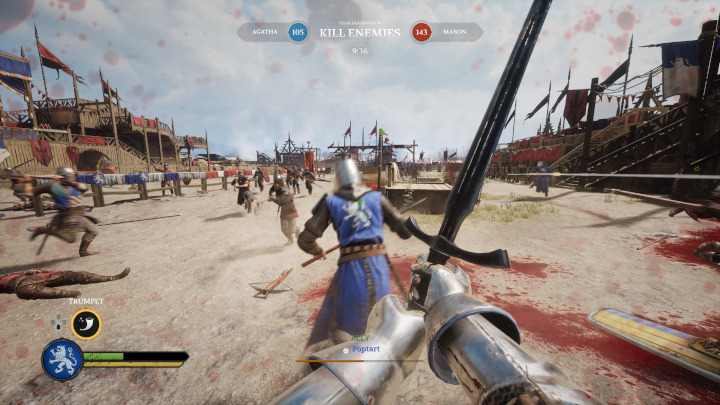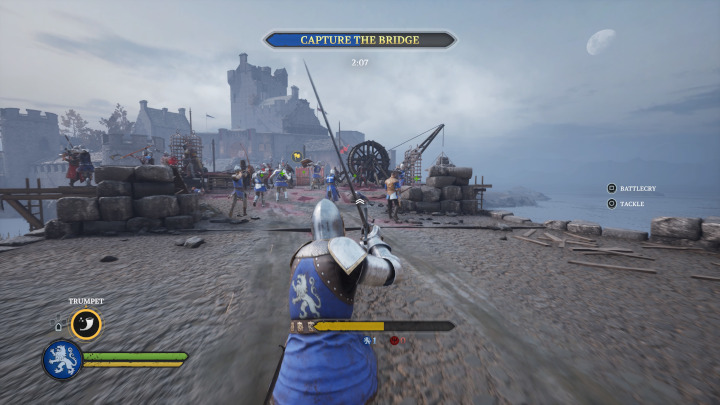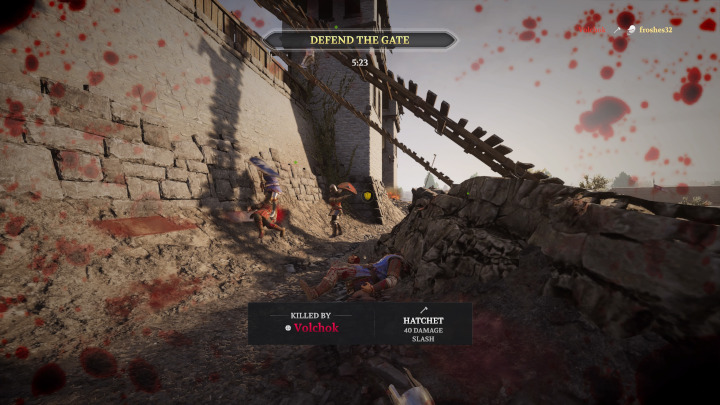
I’ve always had a passing interest in the Medieval first-person battleground genre, but that interest always waned whenever I actually tried to play any of the genre’s offerings. Janky animations and overly technical combat seem to rule the day — or at least they did five or six years ago, back when I first attempted to get into the genre (I admit that I just might not have been playing the right games).
And sure, that’s changed over time. I’ve heard great things about Mordhau, but I suspect it would be a bit too technical for me. What I’ve always really wanted was something that felt kind of like Call of Duty or Battlefield set in the Medieval period — something I could put down for a couple months and pick it right back up to have stupid amounts of chaotic, violent fun.
Well, Chivalry II is finally here to scratch that exact itch.
This is basically a first-person shooter where all your weaponry is swords and axes and bows and arrows (I should point out that you can also switch into third-person if you’d like). It’s not exactly pick-up-and-playable, but there’s a tutorial that first-timers should definitely play through. This training session is a bit tedious, but I played through it twice and learned new things both times. At that point, I was ready to test my mettle (and metal) against enemy hordes of real-life players.

Chivalry II drops you into massive PvP battlegrounds, where you’re either fighting to the death on a battlefield, or you’re storming (or defending) a Medieval village (or prison, or tournament grounds). There are siege towers and catapults and ballistae and fires and whatnot, making every battle feel super chaotic and ever-present — you always feel like you’re only one soldier among a massive battle rather than a singular demigod who’s slaughtering their way through hundreds of paper-thin troops.
I freely admit that melee combat has a little bit of a learning curve. You can swing your weapon in three different ways, you can pivot your body during a swing to increase the speed of your strike, and there’s an ever-present paper-rock-scissors element to which player has the advantage when two people attack simultaneously. There are blocks and ripostes and special strikes and ways to counter or dodge all of those things. It takes a bit of time to learn how to read your enemy to figure out the best strategy in one-on-one combat. Of course, you can always go for the backs of enemies who are preoccupied with other players.
You can still have a ton of fun before any of this starts to feel natural, and I think this is where Chivalry II really shines brightest. If you go into a battle, you’re going to have a blast, even if you suck. The game really encourages you to get out there and become cannon fodder for your enemies, because even that is really, really entertaining. And while you’re grinning like a maniac and swinging your sword around like an incompetent fool, you’ll naturally start to acquire some of the muscle memory you’re going to need to actually get better at the game.
So jump into a match, completely suck, then jump into another one and suck just a little bit less. As long as you’re not aggressively competitive, the process of incremental learning by repeated failure is still enjoyable, even if you never truly master the game.

A huge part of this is just how delightfully violent and silly this is. Blood is everywhere. You can hack off the arms of your enemies. You’ll see ballista bolts pin soldiers to the wall like notes on a bulletin board. You can kill an enemy, sever that person’s head, and then throw the head at another enemy to deal damage. You can also pick up chickens, which turns your entire emote wheel into a selection of chicken sounds. So long as you’re not bothered by the over-the-top gore, it’s really hard to play this game without a huge smile.
I’ve not invested a ton of time into this yet — maybe six hours or so — because E3 was happening right as this was coming out and I was inevitably swamped with other things. But the little bit I’ve played only makes me want to play more. I can see this being something I can casually enjoy over a long period of time (though if I break too long, I might give the tutorial another go before I attempt to battle real human players again).
Oh, and I should mention that this actually plays really well on PS4. I was a little hesitant to try out the console version, hoping for the best but expecting the worst, but the Chivalry II experience translates really, really well to consoles, even the last-gen ones.
That comes with the caveat that Chivalry II supports cross-play, so you’ll be using a controller against keyboard-and-mouse users on PC. If you look at your scoreboard, you’ll oftentimes see the top ranks dominated by what I assume are PC players (you’ll see a PlayStation icon for PlayStation players, and then a sort of globe icon for everyone else, so I assume that represents everyone who isn’t on a PlayStation console).

But that doesn’t matter, because there’s plenty to enjoy here, even if you don’t top the leaderboards every match — or ever.
If you’ve been hesitant to jump into the Medieval first-person battleground genre because it’s too technical or overwhelming, Chivalry II is actually a really good jumping in point. I’d give this two enthusiastic thumbs up, but an enemy fighter just lopped off one of my arms so I’m going to have to just give it one and maybe a wink or something.
The bottom line: Chivalry II is worth your time if you have any interest in the genre at all. It’s just absurd amounts of brutal, violent fun.